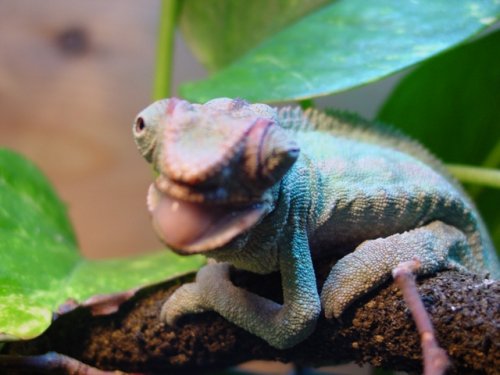sandrachameleon
Chameleon Enthusiast
currently looking after a very small juvi panther chameleon with MBD. He is unable to catch food for himself due to his poor motor control and reduced ability to shoot and retract tongue. He manages to grab very small butterworms if I cool (slow) them and put them immediately in front of him. It takes him forever to get just one. This is the only prey he seems capable of getting for himself. And his jaw is soft so he cant chew, so if I dont puncture the worms well I think they would pass undigested. PUncturing the worm means it doesnt live long, which means it could die well before he manages to eat it.
Obviously a tiny butterworm or two a day is not enough anyhow.
With a previous special needs (nearly blind) chameleon, I was able to just touch a bug to the front of her mouth and she'd grab it. But this little guy is afraid of tweezers and of me. Ive resorted to force feeding. Twice Ive placed tiny crickets, once a tiny silkie, and once a pre-killed tiny super into his mouth, on top of the tongue at the back, using thin tweezers or a narrow rubbery tip thing on a syringe. His mouth hangs partly open all the time, so I didnt have to force the mouth open. But I did have to hold him and he doesnt like that. This is tedious, time consuming, and stressfull for the little fella. He doesnt have opportunity to chew, even if he could, which I think is a problem. Iam not going to get enough food into him this way.
So, I have also been smashing up bugs, removing the larger bits of chinton/shell, mixing with water, and using a small soft tipped syring to "squirt" food into his mouth. this ensures he is getting food and water. But I am concerned with the potential for causing him to aspirate/choke. Not sure how best to drip/squirt the food mash into him.
Looking for suggestions, techniques and methods that work for others please
thanks
Obviously a tiny butterworm or two a day is not enough anyhow.
With a previous special needs (nearly blind) chameleon, I was able to just touch a bug to the front of her mouth and she'd grab it. But this little guy is afraid of tweezers and of me. Ive resorted to force feeding. Twice Ive placed tiny crickets, once a tiny silkie, and once a pre-killed tiny super into his mouth, on top of the tongue at the back, using thin tweezers or a narrow rubbery tip thing on a syringe. His mouth hangs partly open all the time, so I didnt have to force the mouth open. But I did have to hold him and he doesnt like that. This is tedious, time consuming, and stressfull for the little fella. He doesnt have opportunity to chew, even if he could, which I think is a problem. Iam not going to get enough food into him this way.
So, I have also been smashing up bugs, removing the larger bits of chinton/shell, mixing with water, and using a small soft tipped syring to "squirt" food into his mouth. this ensures he is getting food and water. But I am concerned with the potential for causing him to aspirate/choke. Not sure how best to drip/squirt the food mash into him.
Looking for suggestions, techniques and methods that work for others please
thanks
Last edited:








